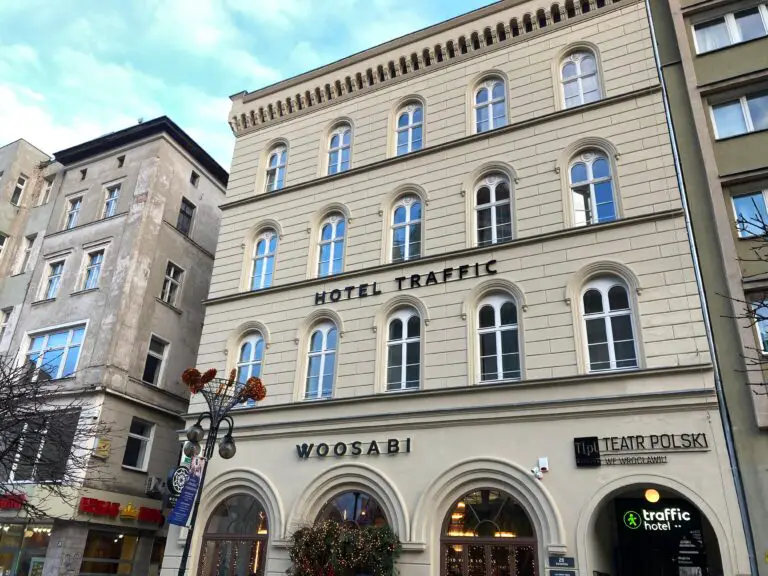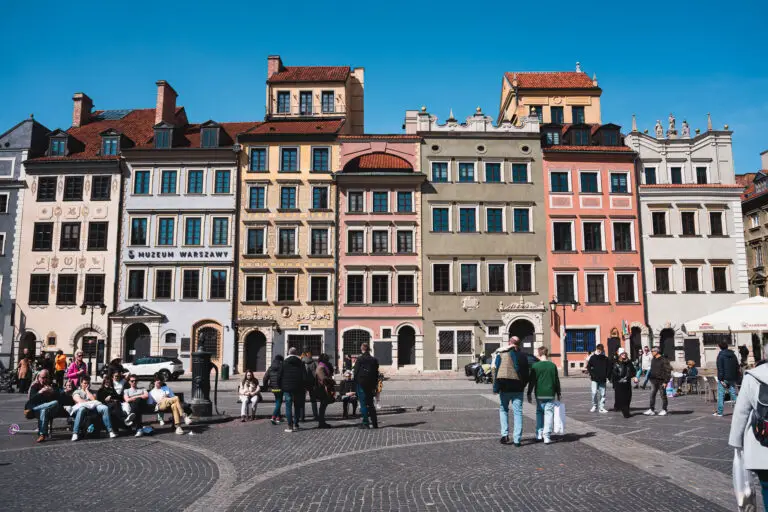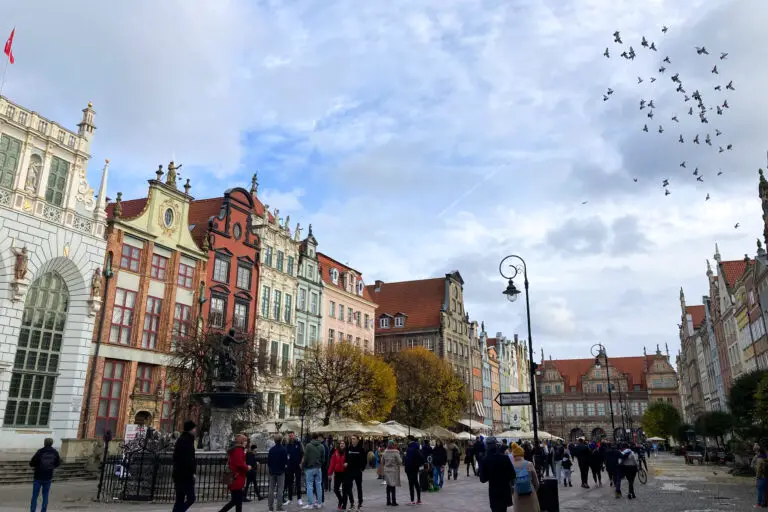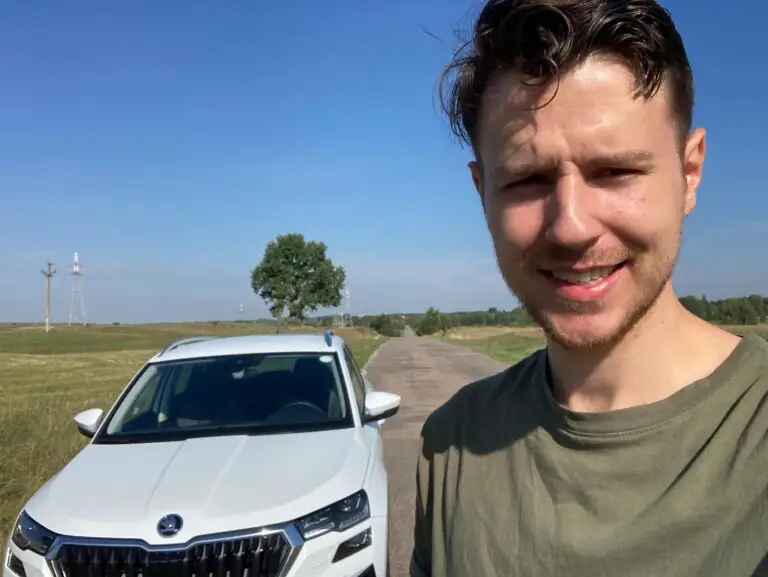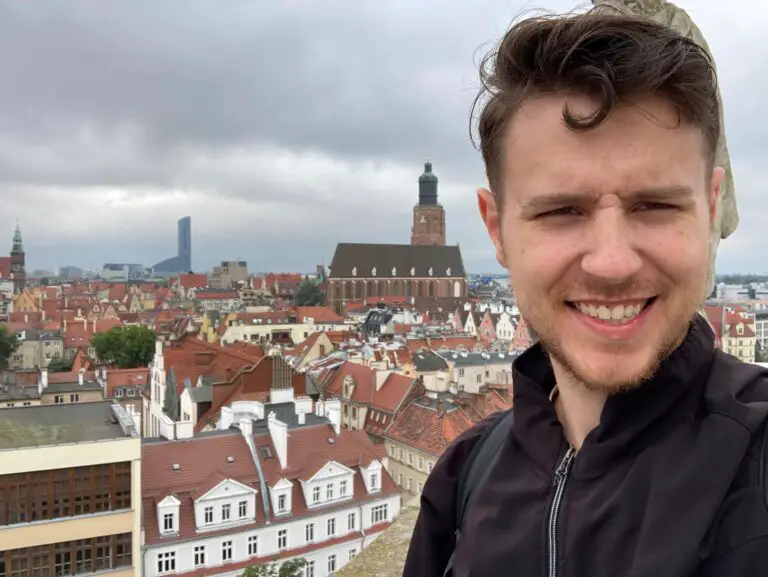15 Best Things to Do in Wrocław: Our 2024 Guide
A list of the best things to do in Wrocław could take up a book (and likely has). While tourists visiting Poland mostly visit Warsaw and Kraków, because of all the amazing things to do, a growing number are visiting Wrocław, the 4th largest city of Poland every year. There are so many wonderful things to do in Wrocław, from visiting colorful and historic buildings, to beautiful parks, and entertaining museums, all centered on the historically important Oder River (called Odra locally). This city of around 650 thousand feels like popular cities like Cologne, Amsterdam, and Copenhagen, while keeping its unique Polishness.
When I visited, I was so enchanted, I wished that I did not have to leave. There were so many things to do, it was hard to narrow this list down to the best 15 things. However, I feel this list includes the best of the best. Some of these attractions may take you only 15 minutes, some may take you half of your day. Regardless, I feel they are the best. There are outdoor and free attractions on this list, some of the best museums, and some attractions unique to Wrocław, such as the Polinka Cable Car.
At the end of this list, you will also find a short guide on everything you should know about Wrocław! From how to get there, and how to use the amazing public transportation Wrocław has, I share everything I learned when visiting for the first time. There are also some safety tips and recommendations on how long you should stay. The only things missing are restaurants and accommodation but keep your eye out for those articles in the future.
All in all, I left Wrocław feeling that I had just left the best city in all of Poland, beating my earlier favorite of Gdańsk. I hope that you will find Wrocław just as enchanting as I did. Read on to find out why, and how to visit.
Planning to visit Wrocław soon?
🛫Booking flights to Wrocław: For booking flights, we love to compare prices on Expedia and Kayak.
🛏️Booking hotels in Wrocław: When looking for hotels, we recommend using Booking.com and Hotels.com. We like the following hotels in Wrocław:
- Hostel Wratislavia (Budget)
- Hotel GEM (Mid-Range)
- DoubleTree by Hilton Wrocław (High-End)
⛪Booking tours in Wrocław: Viator is a great platform for finding tours and excursions to join. The following ones are particularly interesting:
- Wroclaw Food Tasting Tour (Tasty)
- Auschwitz-Birkenau Tour
- Lower Silesia Tour (Very Beautiful)
🛣️Renting a car in Wrocław: Discover Cars is the platform we use when renting a car in Poland.
Best Things to Do in Wrocław
Let’s get to the best things to do in Wrocław.
1. Admire the Wrocław Market Square and Town Hall
Description: The beautiful Market Square should top any list of the best things to do in Wrocław. The beautiful, narrow houses are like those you might see in Gdańsk, another amazing Polish city to visit from Warsaw. The buildings are colorful, picturesque, you name it. The Market Square is one of the largest in Europe and has been around since the 13th century, with only some damage during WWII.
The west side is the most open, with an artful fountain, and the only modern building sticks out here, which houses a bank. There are also many dwarves dotted throughout the square, and tour groups taking pictures of them and everything around. Here on the west side, you can admire the beautiful Town Hall, one of Poland’s landmarks, with its tall tower and beautiful clock on its east side. The outside of the building is beautiful enough, but if you would also like to see some of the inside as well, you can do so by visiting the Museum of Bourgeois Art.

If you want to spend time eating at a restaurant or shopping, there are lots of options for this too along the market square. In my opinion, the best sides are the west and south side, as they have the best views, and some great food too. The north side is full of cheap shot bars, so it can get a bit rowdy at night, and the east side, while having the beautiful clock of the Town Hall, is full of chain fast food restaurants, and lots of activity as people arrive from other sides of the town.
If you want to explore the Market Square area fully, make sure to walk in amongst the buildings in the middle. There are some cool restaurants and shops hidden there, and many tourists do not choose to walk amidst the buildings, so it can also be a great place to sit in the shade and relax away from it all. You can also walk to the adjoining Plac Solny, the former home of salt sellers now home to a flower market, beautiful buildings, and the occasional concert.
All in all, it would be foolish to skip the Market Square and the Town Hall when visiting Wrocław, it is one of the most enchanting places I have visited in all of Europe.
Cost: Walking around the Market Square to take some pictures or just sit and admire the beautiful buildings is of course 100% free. If you want to see the inside of the museum, via the museum, admission costs 15 PLN, or 10 PLN reduced. Costs may differ based on which special exhibition is going on.
Opening Hours: The Market Square is open 24/7. It is most popular from lunchtime to dinnertime hours, from around 12 PM to 8 PM. Visiting at night is cool to see the city light up. If you want to go inside the Town Hall via the museum, it is open from Wednesday to Saturday from 11 AM to 4 PM, and on Sunday from 10 AM to 6 PM. Make sure to show up at least 60 minutes before closing to get in. The Town Hall is closed on Mondays and Tuesdays.
Transit Information: The Market Square is surrounded by tram and bus lines, and most buses connect to the center. On the south side of the city, you can take many major trams that get to other parts of the city, including to the east side where many other attractions are. You should not have any trouble getting to the Market Square no matter where you are in Wrocław.
2. Tour the Wrocław Dwarves
Description: The Wrocław Dwarves are perhaps the most famous symbol of the city. The originated during the communist era of Poland. The dwarves served as a symbol of peaceful protest methods of the Orange Alternative, with dwarves graffitied over pro-communist propaganda on walls and other places in the city. The symbol has endured, and now it is considered a sign of success when a business gets their dwarf.
The dwarves started as monuments, but now you can find all sorts of dwarves scattered at key places throughout the city. Many of the famous ones are near the city center, such as the Sisyphus Dwarves. You can also find a musician dwarf, a sleeping dwarf, a banker dwarf, a tourist dwarf, and even a dwarf riding a pigeon amongst some bird spikes. Finding all these dwarves serves as a wonderful activity for children and adults alike, supplying motivation to walk around and explore the city. Visit the Wrocław Visitor’s Center, linked above, to get more information.
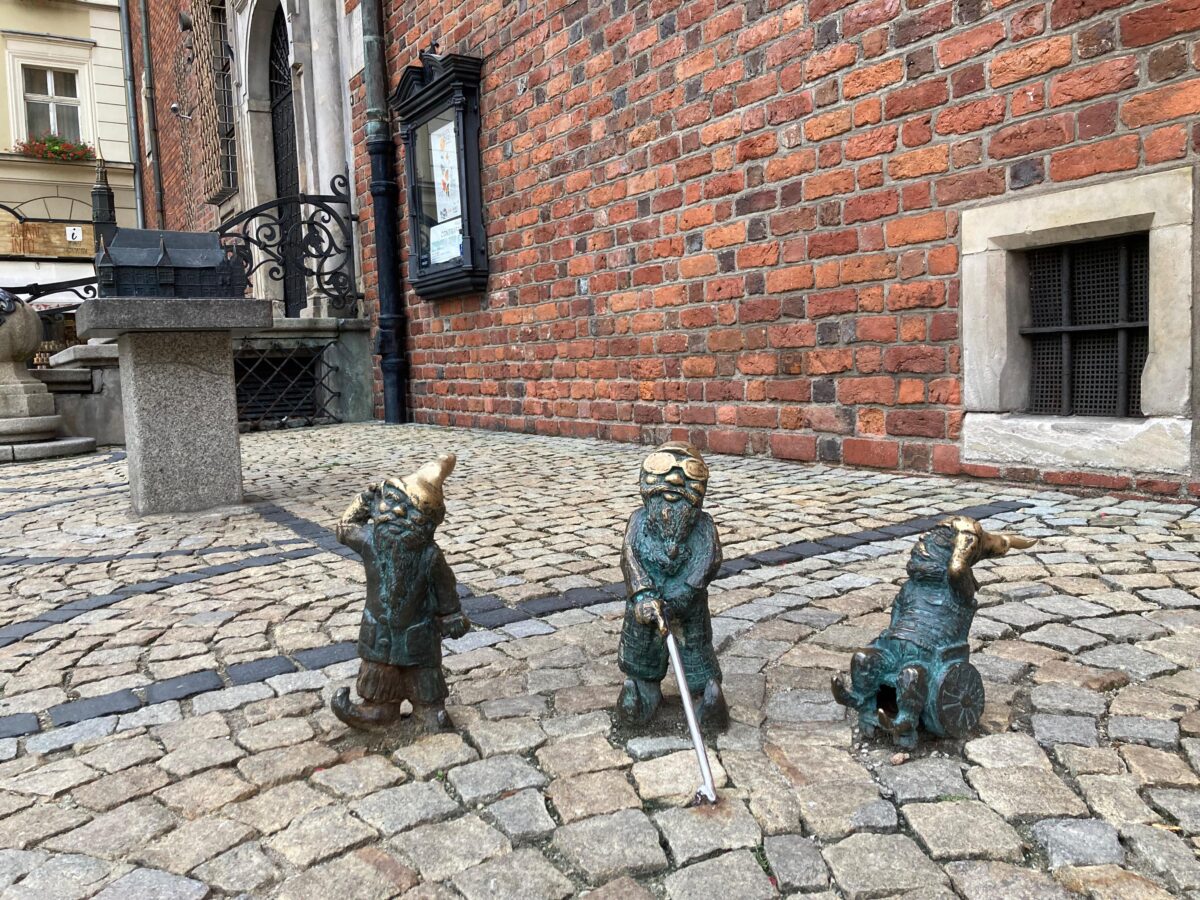
The culmination of the dwarf year in Wrocław is the Wrocław Dwarves’ Festival which happens in September of each year. This festival involves many events related to the dwarves spread out over a weekend. There are children’s games, scavenger hunts, parades, rides, costume competitions, and more to be excited about. If you can come to Wrocław this weekend, it will be an extra magical time, although any time of year is a great one to visit the famous Wrocław Dwarves.
Cost: Visiting the dwarves is entirely free, although you may choose to buy a physical map to help you find them all, although there are free services online to do this as well.
Opening Hours: You can view the dwarves at all hours of day, and you will find them wherever you are. To visit the visitor’s center, it is open from 10 AM to 6 PM every day.
Transit Information: The dwarves are everywhere. The highest number of dwarves can be found in and around the Market Square. So, I have no transit information to provide, this is a scavenger hunt that could take you to every corner of the city.
3. Climb to the Bridge of Penitents
Description: Climbing to the Bridge of Penitents supplies perhaps the best, and most famous, view of Wrocław. The Bridge of Penitents is a walkway between the two tall towers of the Cathedral of St. Mary Magdalene, found just east of the Market Square. This beautiful church has lots of history, and a decadent red and green roof to go with the stunning views of its towers.
After losing your breath as you climb to the 45-meter bridge, you will at once be greeted by two statues, one of an old woman and one of a witch. The story goes that the woman enjoyed partying a bit too much and did not want to have children and keep the house and was punished to sweep the bridge between the towers for the rest of her life. While this story may be a bit old-fashioned in the morals it tries to portray, these statues supply the premiere photo opportunity in all of Wrocław.
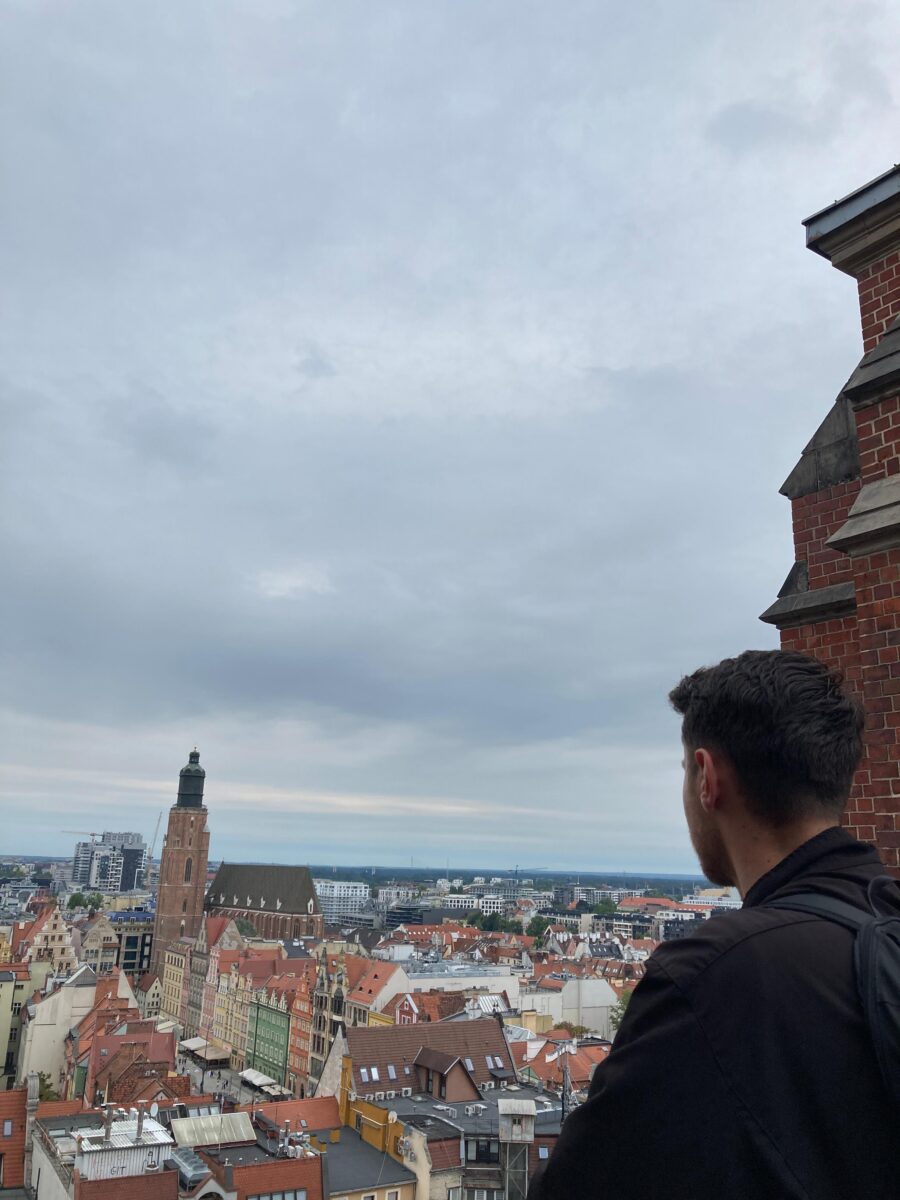
The bridge is very narrow, so only a handful of people can stand there at a time, but while there, you can admire the best view in Wrocław, as you sit above the Town Hall and beautiful Market Square, and can also see the nearby churches, river, and other important sites of the city. I recommend visiting earlier in the day to beat the crowds, or at dinnertime. You will not want to miss the view and story this location provides.
Cost: A normal ticket costs 15 PLN, and a reduced ticket costs 10 PLN. You can peek into the church for free. You can also buy three-person and four-person family tickets for 35 or 40 PLN respectively.
Opening Hours: The website for the church claims the viewpoint is open every day year-round, no matter whether it is a holiday. During the main summer season, you can climb from 10 AM to 8 PM, which means in the late summer you can watch the sunset from there. During the winter, you can climb from 10 AM to 7 PM, which guarantees a sunset slot every day, as well as many hours after dark if you were to want to admire the beautiful Polish winter from above.
Transit Information: The church is east of the Market Square, only a short 3-minute walk away. If you are coming from the north or the south, you can take a tram almost directly there, either Tram 6 or 7 to the Wita Stwosza tram stop. Otherwise, it is easy enough to walk there from other tram or bus lines surrounding the historic city center.
If you are looking for a potentially less busy view, consider the following:
| Name | Height | Price | View Level | Location |
| St Elizabeth’s Church | 91 meters | Cheap (can’t find reliable info) | 360 degrees, narrow terrace | On Market Square |
| Mathematics Tower of the University of Wrocław | 42 meters | 16/12 PLN, but can be bundled with 3 rooms | 360 degrees, very wide terrace, not busy | Very close to center |
| Cathedral of St John the Baptist (Wrocław Cathedral) | 97 meters (Has elevator!) | 15/10 PLN | Very scenic, good views of entire city | Ostrów Tumski, close to city center |
| Wrocław Sky Tower | 200 meters | 30/25 PLN during summer, 25/20 PLN in winter | Only 180 degrees, and still very crowded | Far from beautiful part of the city, still can see |
4. Explore the 4 Temples District and the Vibrant Galeria Neon Side
Description: The 4 Temples District, sometimes called the 4 Denominations District, is not an official district in Wrocław per say. However, it is an area with a huge amount of history that is 100% worth visiting. Poland has been known for its history of religious tolerance (well, at least compared to other European countries), and this is the case here. You will find four different churches here to visit. There is an orthodox church, catholic church, protestant church, and synagogue.
Of course, the neighborhood is more than just these four places of worship. This neighborhood is also a vibrant one, with lots of businesses and nice restaurants, with outdoor seating full of greenery and nice views from the city streets that make up the district. Just walking from each of the four temples will help you see the entirety of this district.
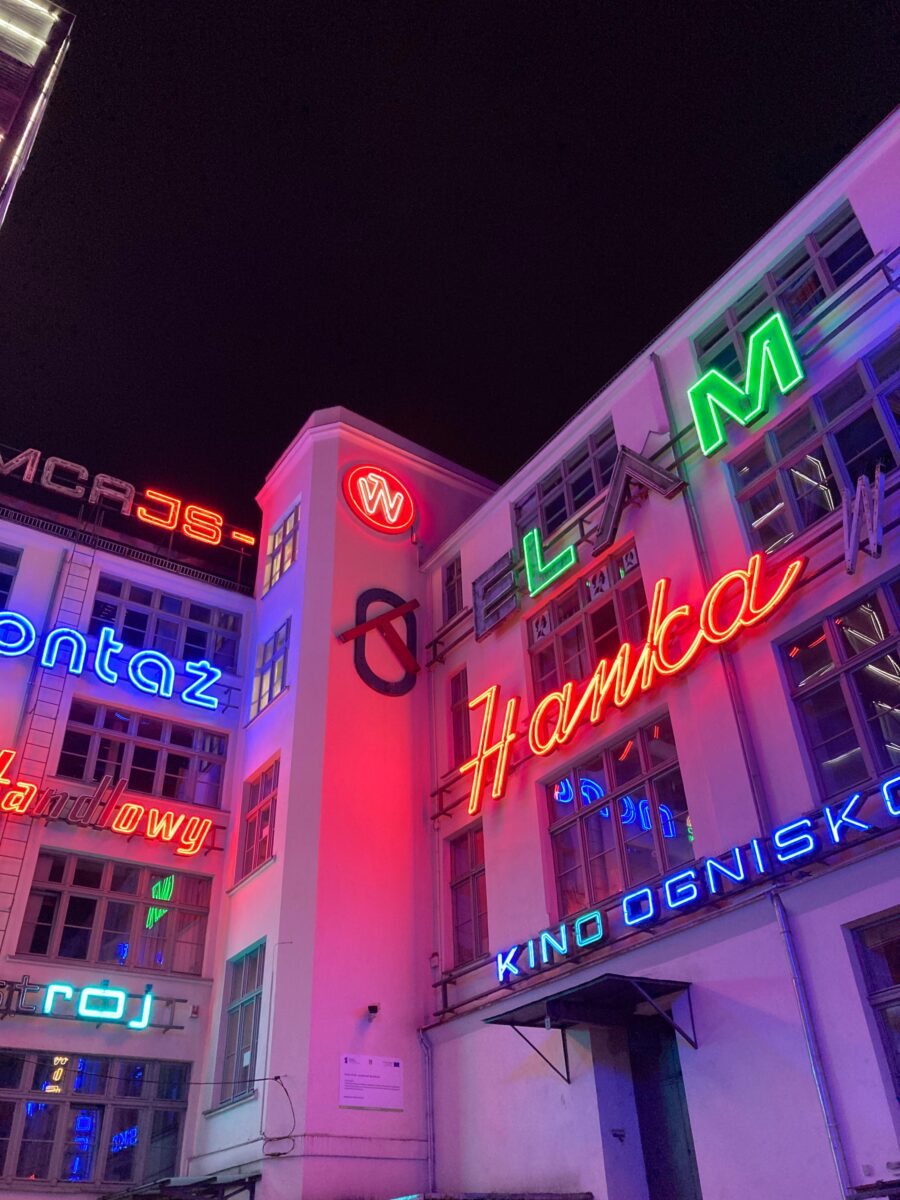
However, the star of the show in this district is the Galeria Neon Side. Hidden away in an alleyway that is easy to miss if you do not know what you are looking for, here you will find remnants of communist Poland, when neon signs were one of the few privileges allowed by the Soviet-influenced government. Today, some of the signs from Wrocław or other cities await you as a perfect place to take photos and admire the colorful beauty of the signs. Overall, a trip to Wrocław is not complete without a visit to these signs.
Cost: Visiting this area is 100% free! You can of course leave donations at each of the places of worship if you follow one of these religions, or otherwise.
Opening Hours: Walking around the area is a 24/7 activity. I recommend visiting the Galeria Neon Side both before and after dark, at both times it is a great time to take pictures and admire the beautiful lights. An hour after sunset should be late enough to have it dark enough. Look up each individual church or synagogue to see when opening hours are.
Transit Information: This area of Wrocław is close to the Rynek tram stop, with trams coming from all over Wrocław. Or if you are coming from the west, you can get off at John Paul II Plaza. The area is very walkable and not super large, so once you get to a nearby tram station you should be good to go.
5. Explore Historic Ostrów Tumski
Description: Coming to Ostrów Tumski means coming to the oldest and most historic part of the city, even older than the area surrounding the Market Square. Ostrów Tumski was established as an area full of churches and places of worship on what used to be an island that no longer exists. However, the Oder is still an essential part of Ostrów Tumski, as the many churches and beautiful, red-roofed buildings overlook the slow-moving river.

The most popular place to visit here is the Wrocław Archcathedral, with its towering double-towered façade overlooking a narrow street full of beautiful, decadent buildings. Here, you can choose to peek inside, or do what many tourists do and climb to the viewing terrace. Conveniently, this viewing terrace involves a smaller number of steps, as an old elevator takes you most of the way up to the top. Once at the top, you can better see all the beautiful buildings of the neighborhood, as well as the Old Town from a distance, and the Oder River up close.
Other worthwhile activities in the area include taking a walk across the many bridges over the Oder nearby, including the iron Tumski Bridge that supplies a great photo spot for the archcathedral. Walking along the river here is also a major highlight. If you want something else to do, the archcathedral offers paid entry to its baroque chapels, where you can be treated to the typical over-the-top interiors of catholic churches and cathedrals throughout Poland. Overall, Ostrów Tumski is not a place to skip when visiting Wrocław.
Cost: A ticket to either the viewing terrace or the baroque chapels costs 15 PLN or 10 PLN reduced. The tickets cannot be bought together except for if you are in a group (when groups are allowed). The price is worth it; the view is quite good.
Opening Hours: The viewing terrace and baroque chapels are open Monday to Saturday from 10 AM to 5 PM, and on Sundays from only 2 PM to 4 PM. You can also visit the churches at these times. The church is off limits during services. The churches are also off limit to large, guided group tours, ensuring peace and safety. The rest of Ostrów Tumski can be toured at any time you want, although during the day is the best time.
Transit Information: Ostrów Tumski is very close to the city center, and there are many trams you can take to it from other parts of the city. Once you arrive at the Hala Targowa tram station south, or pl. Bema tram station north, you can walk across the beautiful bridges over the Oder onto the islands, and then across Tumski Bridge to get to Ostrów Tumski.
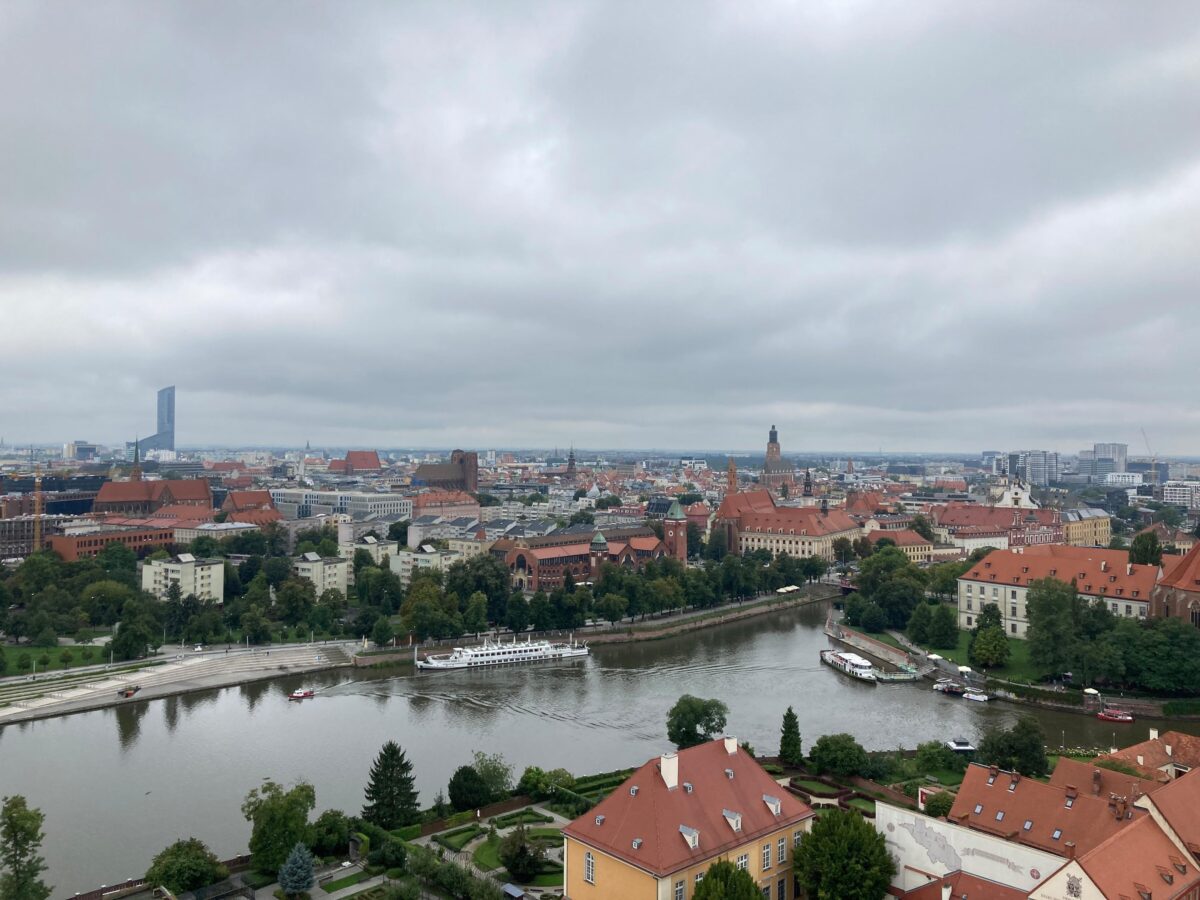
6. Explore the Oder River
Description: The Oder River is likely the second most important river in Poland, behind the Vistula River which flows through Warsaw, Kraków, and near the Katowice metropolis. Wrocław is the most important city on the river, that eventually makes up most of the border between Poland and Germany. The city itself was built around the many islands on the river, which is why Wrocław is sometimes called the city of bridges, both due to the high number and beauty of the bridges.
Walking around the river is a highlight of any trip to Wrocław, as I felt like I was walking through a much quieter version of Amsterdam, with the architecture being reminiscent of that Nordic style common in Copenhagen, or in Gdańsk for a Polish example. There are many beautiful spots to sit on a bench and admire the views provided, and many restaurants or bars if you want to enjoy a bite to eat or a round of drinks while appreciating the river.
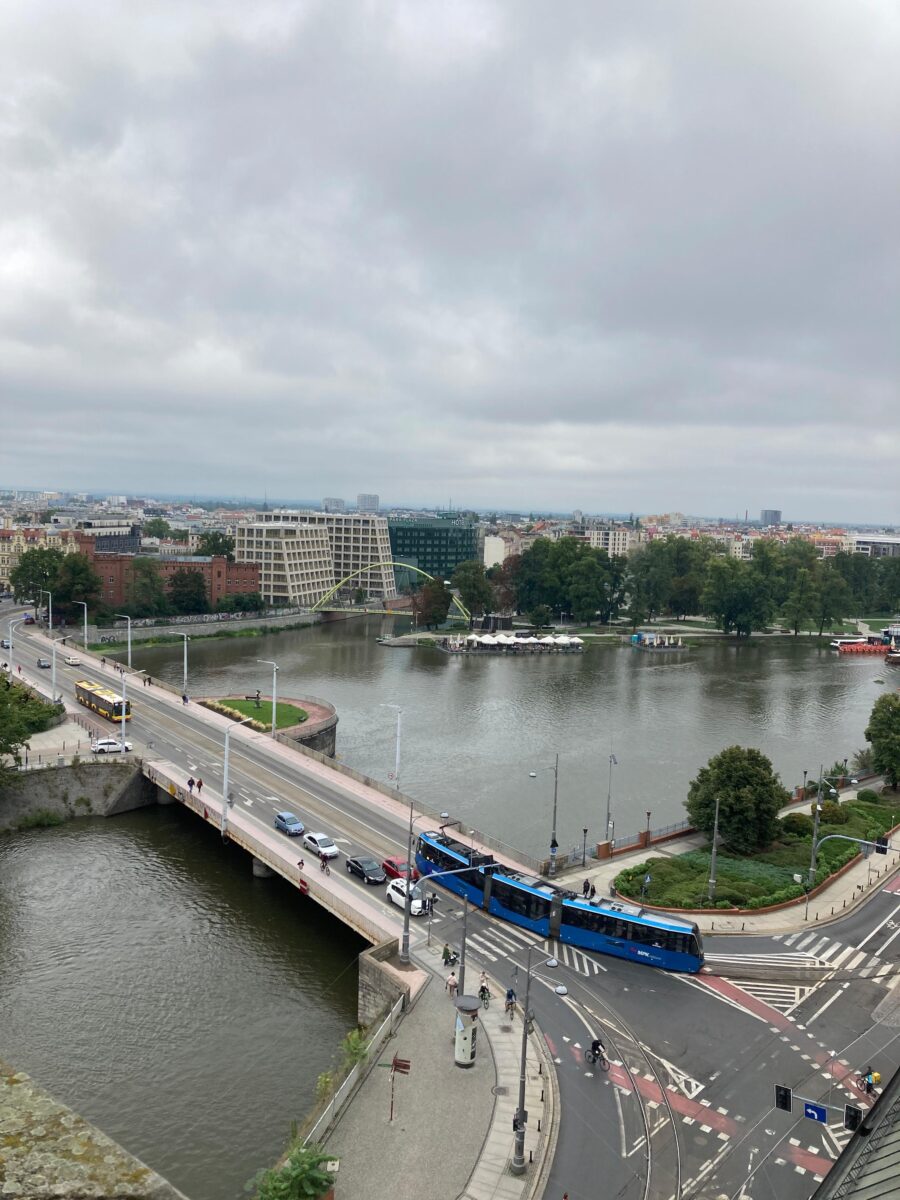
If you want to go out on the river, boating is a huge part of Wrocław’s tourism, with boats leaving from almost everywhere along the river. The most popular place to leave is Przystań Turystyczna, found not far from the city center. Here, boats leave every hour for a 45-minute tour of the city via the river. However, these tours are typically provided in Polish only unless you get special arrangements ahead of time.
Overall, I think walking along the river somewhere is enough. I chose to skip the boats because they did not seem as popular then (possibly because I had cold and cloudy weather when I was there in August), and because I got to go at my own pace by taking a nice long walk. But the boats are still a good choice, especially if you want to practice your Polish or have a larger group with you.
Cost: A single ticket costs somewhere between 40 and 50 PLN, depending on the time of day and what discounts you are eligible for. If you want the boat all to yourself as a party boat, maybe for a group trip or a bachelor’s party, you can reserve the boat for a higher cost as well, and you should visit the website linked above for more information. Doing your own personal tour is free of course.
Opening Hours: The boats run during the summer season, from May to September, starting in the morning, to after sunset, when night cruises are available. Check each individual boat’s schedule on the website, but it is likely the hour you want to take a boat is available.
Transit Information: The boats leave everywhere, but the main place to leave is right by the Hala Targowa tram spot. If you just want to walk along the river, walking north from the city center will get you there, and then you can choose your own path. There are many buses and trams found along the river to get you home after you have completed your walk, read further for my transit information at the end to learn more details about how to pick the right one.
7. Have Fun in Szczytnicki Park
Description: This park with the hard-to-pronounce name is the biggest and best in Wrocław. Covered with trees so thick in points the sun is blocked out by the leaves (only in the summer of course), this park is a perfect place to walk around and explore, or to take your kids so they can run around and lose some energy. There are a few playgrounds, statues to explore, and massive fields perfect to kick a football around or throw a frisbee.
If you do not have kids, I would recommend just taking a leisurely walk around the entire park, enjoying the quiet. Unlike Central Park in New Yor, Szczytnicki Park was relatively quiet when I visited, with mostly locals walking around this beautiful place. Thus, you can enjoy the beautiful oak trees, canals, ducks, and other animals, as well as rock gardens and rose gardens.
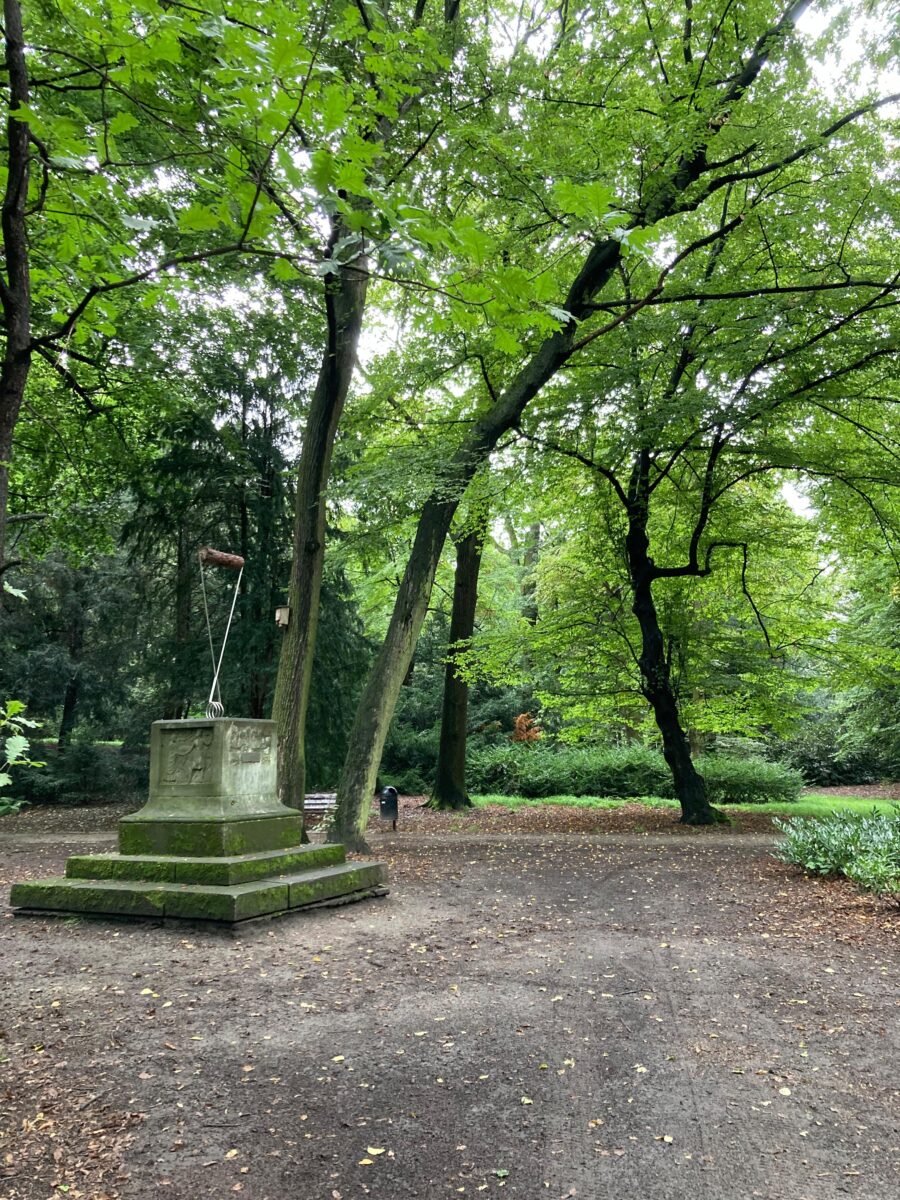
If you want some more action, the southern part of the park is full of many different attractions that you can visit, some of which will be covered later in this article. These attractions include the iconic Centennial Hall, the Multimedia Fountain, the Four Domes Pavilion, and the Wrocław Japanese Gardens. Just south of the park you can also find ZOO Wrocław as well. Basically, Szczytnicki Park is a great place to take a breather after visiting some other attractions of Wrocław, and even without these attractions is a worthy place to visit on its own.
Cost: Wandering around Szczytnicki Park is of course entirely free. There are attractions within the park that do cost money, but that will also be covered later in the article.
Opening Hours: You can wander around the park 24/7, although it only really makes sense to walk through and explore the park during the day. It can be especially refreshing to take a walk here during the morning.
Transit Information: Szczytnicki Park is slightly removed from the center of Wrocław, just to the east. There are many tram lines that run to the park from the city center. If you want to go to the north end of the park, where there are more trees and the playground is, take Tram 9, 17, or 33 from their stops near the center. If you want to go to the part of the park where the museums and attractions are, take tram 2, 4 or 10 to get there. There is some parking available, but it is very limited, so public transportation is best.
8. Visit the Wrocław Japanese Gardens
Description: The Wrocław Japanese Gardens are found within the friendly confines of Szczytnicki Park, and visiting them is certainly one of the best things to do in Wrocław. Located a short distance from other popular Wrocław attractions that will be listed at once after, these gardens are a way to marvel in the beauty and tranquil peace and quiet of a set of Japanese-style gardens. I was reminded of some of my favorite gardens from back home (Kubota Gardens in Seattle if anyone is interested), and that is one of the best compliments I can give them.
You buy your tickets at the gatehouse found near the Multimedia Fountain and walk through a wooden Japanese arch to start. Along the way, you will be greeted by beautiful tree work, cobblestone paths, small and large ponds, beautiful wooden pagodas, wooden bridges arching over the ponds, and fun-to-cross steppingstone bridges. The kids I saw here seemed to enjoy it just as much as I, especially the large koi fish in the pond that occasionally swam to the top to look for food (or fingers).

Currently, the gardens have signs that show which way you must go, so you are not necessarily allowed to wander through freely. However, most people I saw ignored the signs, as there was no one enforcing them. You can just choose to take another lap around if there is something you want to see again, there is no rule against that. Whatever number of laps you want to take, the Wrocław Japanese Gardens are worth visiting when coming to Wrocław, especially since you will likely already be in the area.
Cost: A regular ticket costs 21 PLN, and a reduced ticket costs 14 PLN. You can buy tickets from the kiosk found right at the gate of the gardens; you cannot miss it when walking through the rest of the park.
Opening Hours: The gardens are only open from April to October. During these months, the gardens are open from 9 AM to 7 PM every day, so pretty much every hour there is daylight from spring to fall.
Transit Information: The Japanese Gardens are in a part of Szczytnicki Park away from tram lines. But it is only about a 5-minute walk south to the tram lines between Zoo Wrocław and Centennial Hall. These trams will take you back to the city center. If you choose to wander through the rest of Szczytnicki Park after finishing with the gardens, you can also take the trams that run north of the park back to the center.
9. Visit the Historic Centennial Hall
Description: Centennial Hall is a grand, circular exhibition building that was built from 1911-1913 while Wrocław was still a part of Germany. The hall was built at an astonishing pace, with the intent to serve as a location for concerts, theater performances, sporting events, conferences, and summits of any sort. This massive landmark of Poland sticks out in the east part of Wrocław as an icon of the city. As such, Centennial Hall was recognized as a UNESCO World Heritage Site, and this designation alone should make you interested in visiting.
The hall is one of the earliest examples of reinforced-concrete architecture style, and in a sense, appears as something that could have been built much later than it was. It was built in commemoration of the defeat of Napoleon at the Battle of Leipzig and keeps this celebrative appeal today. The multimedia exhibition inside offers a look into the entire history of the building, from construction to present, and the many events that took place. There are many different displays available with interactive capabilities, and even a virtual tour you can take that allows you to meet the architect of the hall, Max Berg.
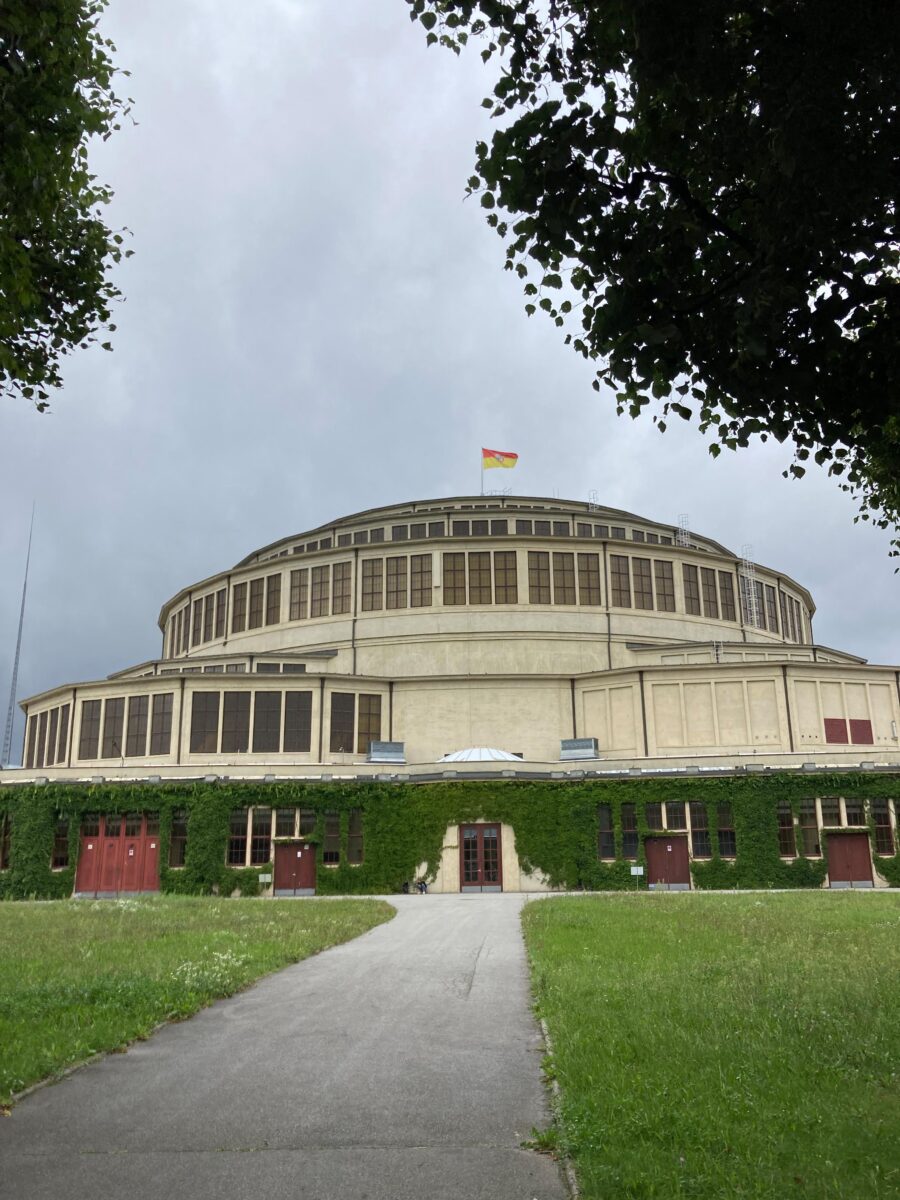
All in all, the grandeur and history of this building, as well as the unique architectural style that is distinctly different than others you will find in Wrocław makes it worth a visit. As it is surrounded by so many other popular places in Wrocław, it is easy enough to walk inside and take a step back into Poland 100 years ago.
Cost: If you want to see the interior of Centennial Hall, you can buy a ticket that includes admission to the multimedia exhibition for 30 PLN or 25 PLN reduced. If for some reason you only want to see the multimedia exhibition, you can buy those tickets for 25/20 PLN, although the extra 5 PLN is probably worth it.
Opening Hours: The visitor’s center, where you start your journey into the hall, is open in the summer season (April to October) from Tuesday to Sunday from 10 AM to 6 PM. The rest of the year (November to March), the visitor’s center is open Tuesday to Sunday from 10 AM to 5 PM. The visitor’s center is not open on Mondays year-round.
Transit Information: There are tram lines running directly south of Centennial Hall, as mentioned in the entry for Szczytnicki Park. Read there for further information on how to get to Centennial Hall, as the instructions are the same.
10. Enjoy a Concert at the Wrocław Multimedia Fountain
Description: The Wrocław Multimedia Fountain is the largest fountain in Poland and is certainly one of the best things to do in Wrocław. Located in the shadow of Centennial Hall in Szczytnicki Park, this is no ordinary fountain. Multiple times per day, for between 4 to 20 minutes, the fountain comes alive with music. The fountain sprays water high into the air, lights flash, and music booms throughout the surrounding park. At night, the lights brighten the air, and the occasional fireworks may even explode.
I encountered the fountain when I heard some Madonna booming from nearby the Japanese Gardens. Once there, I was treated to a mix of pop music, from Beyonce to Daft Punk, and even some James Brown. However, there are so many music choices depending on which hour you arrive, all with perfectly choreographed effects in the fountain. You can choose from Wagner, Beethoven, and Mozart to Hans Zimmer and Daft Punk. And on the weekends, you can enjoy special shows that last for sometimes over 20 minutes.
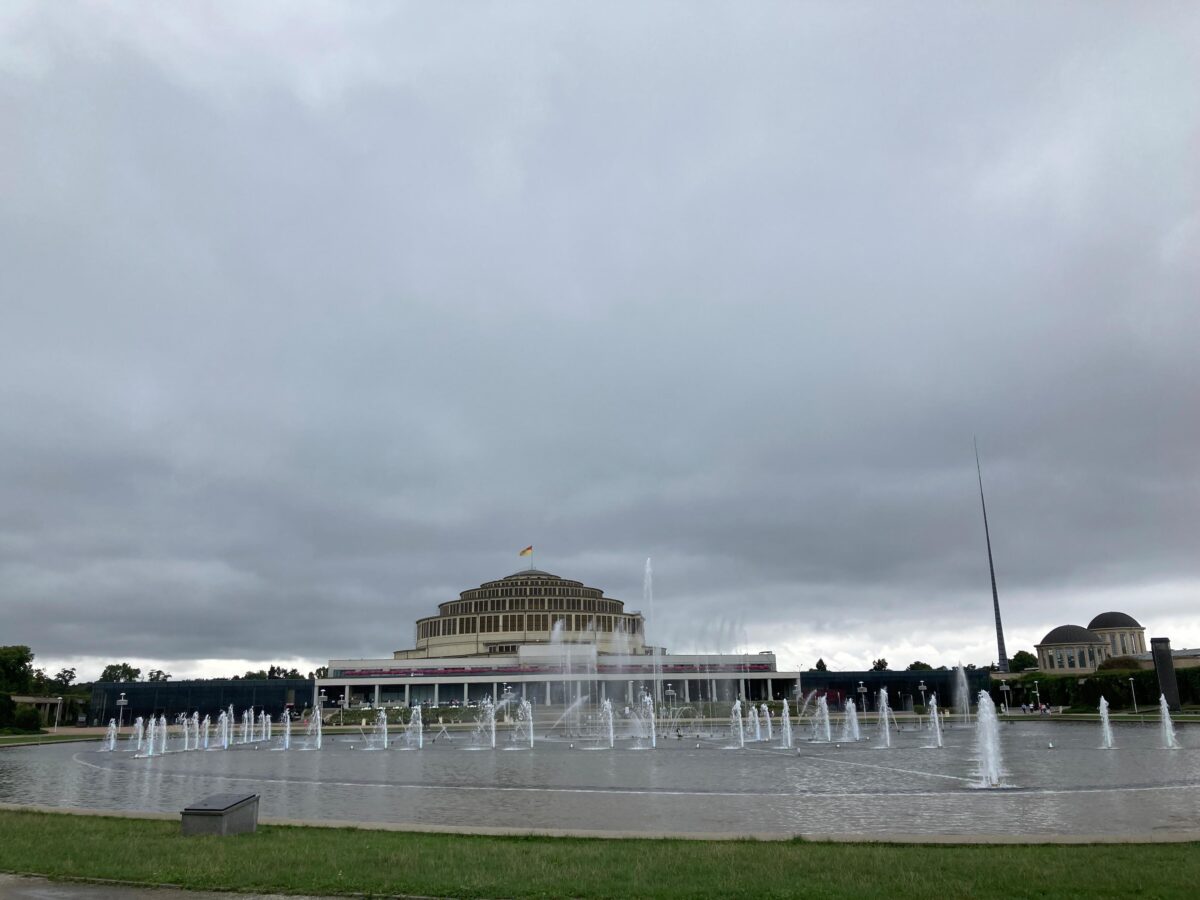
You are likely to be in the area anyway due to all the Wrocław destinations within the park, so it is worthwhile to be at the fountain when the music starts, find a seat, and enjoy the music and show. It can get quite popular depending on the day and season, so expect many even over 1000 people depending on which show it is (I only had about 15 people for comparison at 1 PM on a Wednesday). Regardless of the crowd, this fountain is worth the visit.
Cost: Enjoying the concert is entirely free! The only costs are getting there, and paying for parking if you are driving.
Opening Hours: The first important note is that the shows only run during the warm months, so from May until September. There are shows every hour on the hour, starting at 10 AM. Depending on which month it is, there are shows quite late, but as of September 2023 the latest show starts at 9:40 PM as a special finale show until 10 pm when the fountain shuts down. There are also special shows at 9 PM every Friday and Saturday that last a bit longer and are more popular. Visit here for a full schedule.
Transit Information: Please reference transit notes for Szczytnicki Park and Centennial Hall. But for a small amount of detail, the closest trams are just south, by the zoo, and from here it is about 10 minutes to the city center.
11. Visit the Jaw-Dropping Panorama Racławicka
Description: There is no word to describe the experience of visiting this beautiful piece of art other than awe-inspiring. This painting is a massive 360-degree panorama that was originally painted and found in the now-Ukrainian town of Lviv. The painting depicts a very important battle in Polish history, that happened at the plain of Racławicka. This battle was led by famous Polish war hero (who also fought in the US revolutionary war) Tadeusz Kościuszko, with the battle an attempt to revolt against Russians after the recent 2nd partition of Poland.
The picture depicts the ups and downs of a battle, with horses, large groups of soldiers fighting with sabers and muskets, poor farmers dying in the crossfire, the taking of the cannons, and the eventual retreat of the Russians. While the painting may not be of the same quality as a master such as Picasso or Van Gogh might paint, it is still a super impressive and realistic painting due to its massive size.
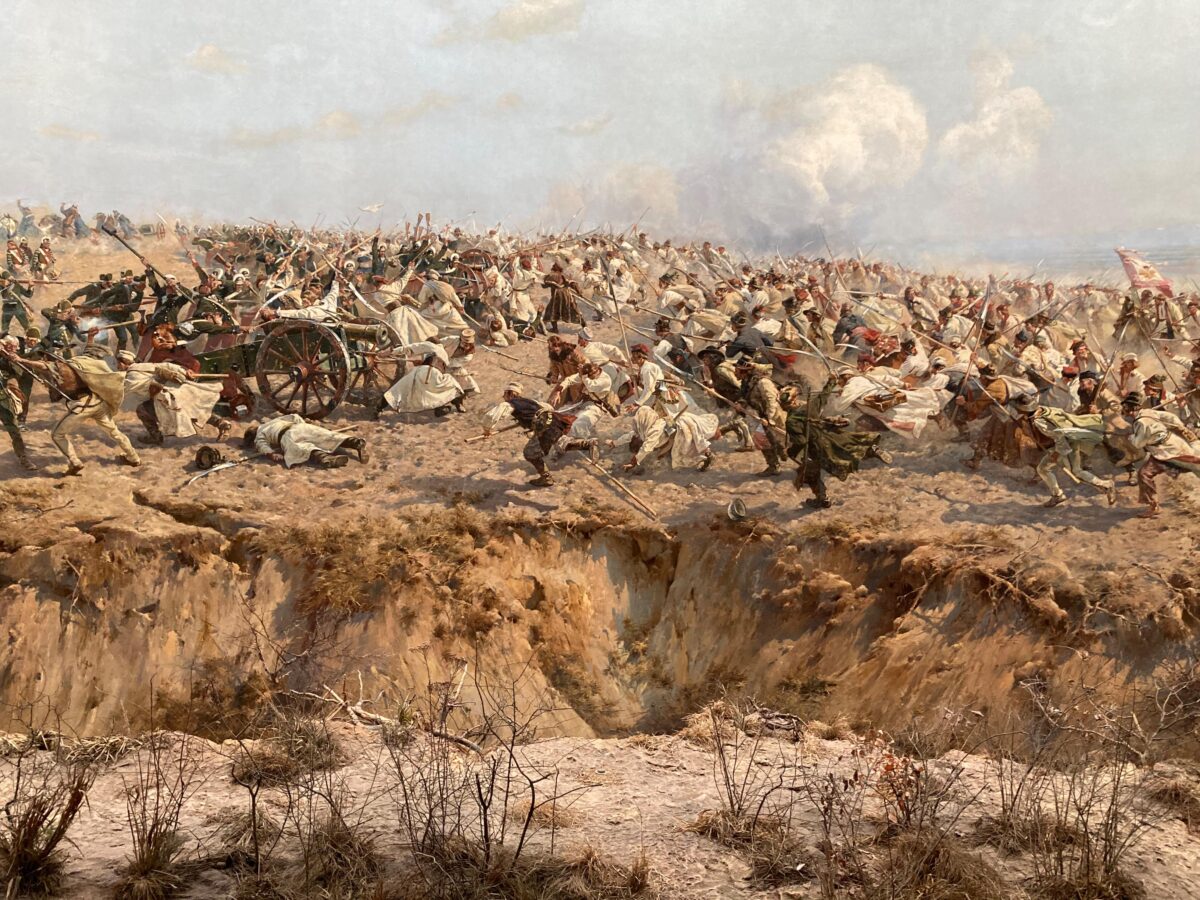
Once you are guided in for your 30-minute time slot, you can grab a complimentary audio guide, offered in many different languages. This is necessary, as the narration of the entire painting is otherwise in Polish. The audio guide will slowly lead you around the painting, explaining the history behind every moment depicted in the painting, and describing many details.
All in all, this experience is such a cool one. Being surrounded by a massive painting that also has dirt and plants in front of it to add to the realism is a unique experience. Thus, if you come to Wrocław, and only have time to visit one museum (although you should visit more), this is the museum you will want to visit, it is one of the best things to do in Wrocław.
Cost: A ticket is pricey for the time you get to spend, at 50 PLN or 35 PLN reduced. However, buying a ticket gets you free admission to three other popular museums within 3 months of visiting the panorama. These include the nearby National Museum, the Ethnographic Museum, and the Four Domes Pavilion. All you must do is show your ticket from the Panorama. Tickets can be bought ahead of time at the website linked above.
Opening Hours: The Panorama is open daily from 8:30 AM to 7 PM. This will be a quick trip, since your ticket only gets you 30 minutes of viewing time.
Transit Information: The Panorama is only about a 10-minute walk from the Market Square. The closest tram stations not in the city center are Urząd Wojewódzki (Muzeum Narodowe) and pl. Nowy Targ. The trams that stop here come from all over Wrocław.
12. Visit the Beautiful National Museum in Wrocław
Description: The National Museum in Wrocław is just like its main branch in Warsaw, which is one of the best museums in Warsaw. The museum is host to a massive collection of art, dating from centuries ago when Poland was full of castles, churches, and serfs, to the modern ages, with most art being from local locations. As you walk each of the three floors of the museum, you will learn something new about the history and culture of Wrocław, and Poland.
I found this museum to be a good way to pass the time. Even if you are not a history or art guy, which I personally do not fall under either of those categories, there is something to enjoy, whether it be looking at some of the funny facial expressions on some of the artwork or admiring the large collection of silverware. This museum is as diverse as it is large. It also has multiple kid-friendly exhibits, with the ability to touch replicas of certain pieces of art.
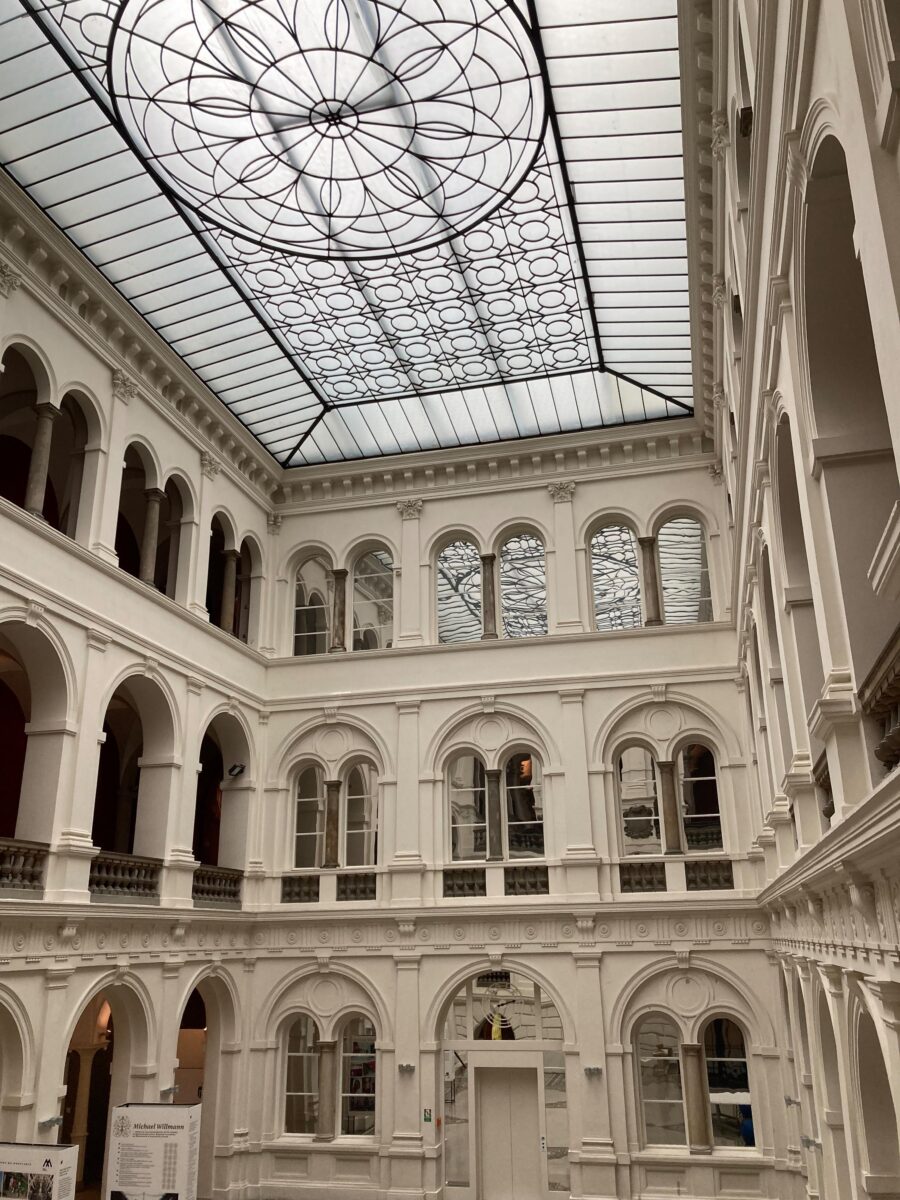
Of course, if you get bored of the inside, the outside of the building is also a tourist attraction on its own. This museum is covered in ivy from top to bottom, which combined with the beautiful brick walls creates a dynamic exterior that is maybe the most beautiful building in all of Wrocław. During the fall, photographers flock to take pictures of the museum as the ivy changes color and becomes even more beautiful than it already was. Regardless of whether you go inside, stay outside, or do both, the National Museum is worth a visit when coming to Wrocław.
Cost: Visiting the permanent exhibits at the National Museum is completely free if you have a ticket from the panorama. If you want to add the temporary exhibits as well, which are never free, this costs 10 PLN or 7.50 PLN reduced. If you are not interested in visiting the panorama, you can also buy individual tickets for just the National Museum. The permanent exhibits cost 20 PLN, or 15 PLN reduced and are free on Saturdays. If you want to access both the permanent and temporary exhibits without a panorama ticket, this costs 25 PLN or 20 PLN reduced.
Opening Hours: The National Museum is open from 10 AM to 5 PM Tuesday to Friday, and 10:30 AM to 6 PM Saturday and Sunday, and closed on Mondays. The museum is also closed on major holidays too.
Transit Information: Just like with the panorama, the closest stop for a tram is Urząd Wojewódzki (Muzeum Narodowe), which is a given since the panorama and museum are right across the street. Thus, it is very easy to first visit the panorama and then head right over to the museum with your free admission. It is also a beautiful 10–15-minute walk from the Market Square if you would prefer that.
13. Meet Some New Friends at ZOO Wrocław
Description: I would usually not feature a zoo on the best things to do in a city, but ZOO Wrocław is one of the best in Europe, and this makes it one of the best things to do in Wrocław. With over 10 thousand animals, and well over 1 thousand species, and with some days in the zoo getting almost 30 thousand visitors, all these numbers indicate a zoo that is worth your time. And if you have kids, you might have a hard time getting them to leave the highly educational setting of the zoo.
What is especially appealing about this zoo compared to others in Poland is its strong sense of caring about the earth, and preserving the diversity of animals on the planet, while teaching about what beautiful animals there are and what needs to be done to save them. All the regular zoo animals are here to see, from bears to rhinos and kangaroos, all in large and engaging habitats.
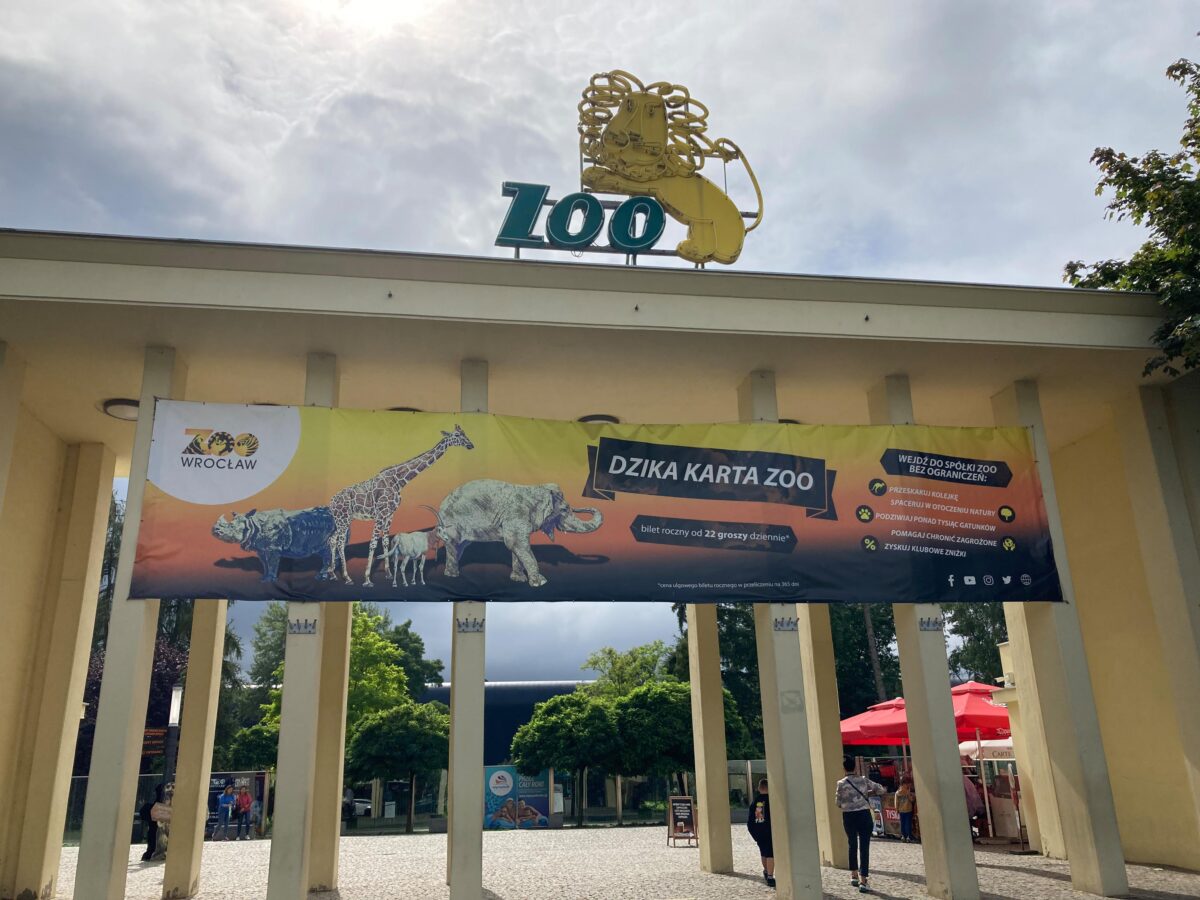
However, the largest draw of the zoo is the African exhibit, or Afrykarium. The Afrykarium is the first and largest oceanarium in all of Poland and is also the only oceanarium in the entire world dedicated to the underseas habitats of Africa. This exhibit has raised the status of Zoo Wrocław to world-class, and is a place you will spend many hours, as you walk beneath the waters and learn about African wildlife.
Of course, be aware that depending on the season, and even during the summer, there will be large groups of children here, so do not expect it to be a quiet environment, even if you get there right at opening. So, this may not be the place to go as a solo traveler. But, if you have a romantic partner, or a bunch of kids (or even one), this will certainly be a place in Wrocław you want to visit for half of a day.
Cost: A regular ticket to the zoo costs 70 PLN, and a reduced ticket costs 60 PLN. This is the price when you buy at the ticket office, the ticket vending machines, or online. However, if you have someone who qualifies for a reduced ticket, you can get a 50 PLN ticket if you buy it at the ticket office on the same day. Additionally, if you have a large family, you can buy the family ticket for 230 PLN. This includes admission for 2 adults and up to 3 kids, and for a family of 5 this is savings of 90 PLN and for 4 30 PLN. All tickets include admission to the entire zoo, including the African exhibition.
Opening Hours: The zoo is open year-round, even on public holidays. The hours change quite often depending on the month. However, the zoo always opens at 9 AM, and closes anywhere from between 4 PM and 7 PM, with the African exhibit often being open an hour later than the rest of the zoo. Visit the hours here for exact hours for the month you are visiting.
Transit Information: There are tram lines running directly north of the zoo. Read the entry on Szczytnicki Park for further information on which exact trams run to the center, as the same info applies here as for the park.
14. Take the Wrocław Polinka Cable Car
Description: What might your solution be when your university students complain about getting stuck in traffic while commuting from one part of a campus to another, and thus being late for class? How do you manage if there is also a river in the way? The Polytechnic University of Wrocław’s solution was to build a cable car across the river, creating a unique commuting experience that is hard to find anywhere else in the world.
The ride is short, only about 2 minutes, and only two cars run at a time, one in each direction, each taking no more than 10 passengers. But while the experience is short, the novelty makes it worth the trip. And, with the campus’s location close to Szczytnicki Park, it is a fun way to cross back over to the south side of the river. The mom and son with me certainly enjoyed it, and I think you will too.
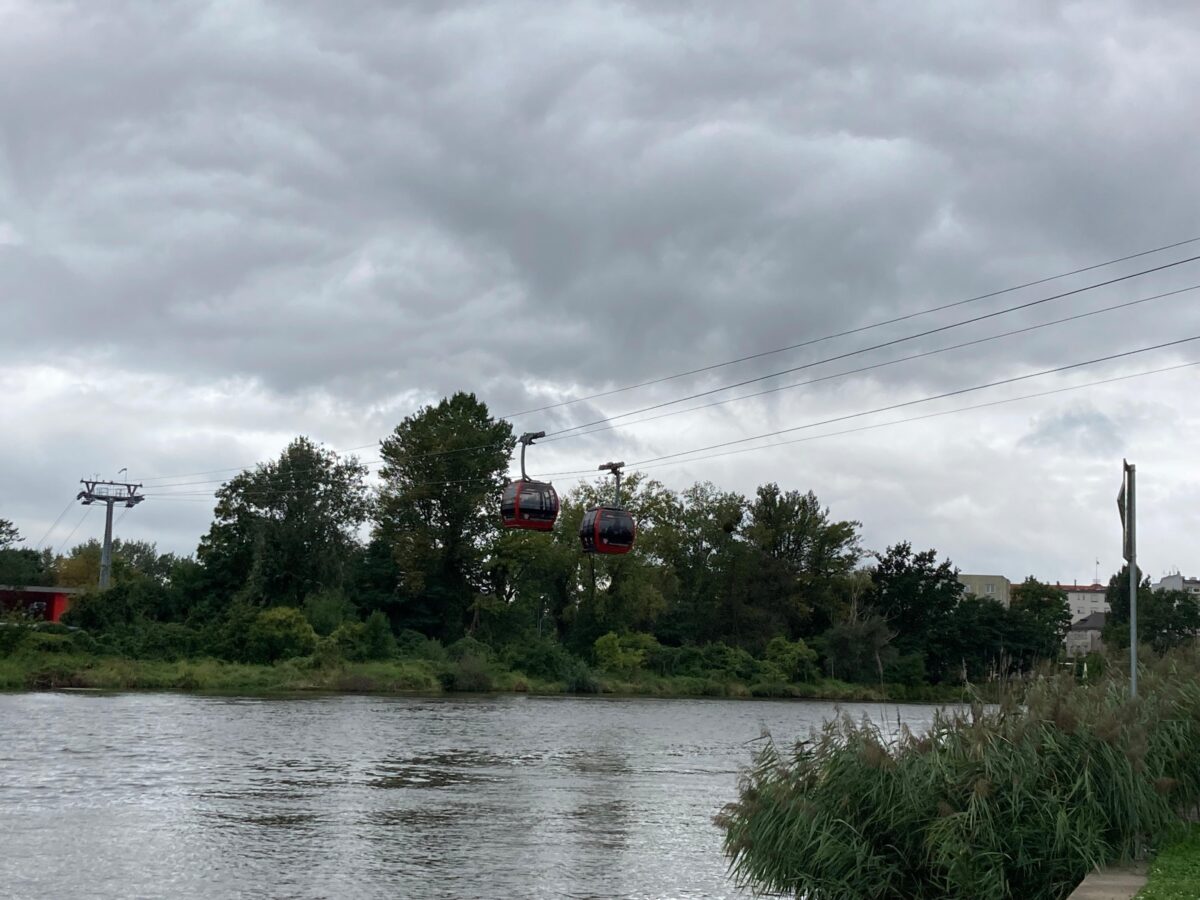
Cost: While the cable is free for university staff and students, it does cost money for tourists. You can buy your ticket at one of the ticket machines at either end of the cable car. A normal ticket costs 3 PLN, and a reduced ticket costs 1.50 PLN, these prices being for one direction. Do note that if you buy a Wrocław public transportation ticket, it does not apply to the cable car, you must buy a separate individual ticket. Make sure to confirm before entering!
Opening Hours: The cable car runs daily. On school days, Monday to Friday, it runs from 7 AM to 9 PM, and on weekends it runs from 11 AM to 6 PM. There is a break in operation from 1:30 PM to 2 PM every day. On major holidays, the hours differ.
Transit Information: Part of the reason for the cable car’s existence is that the area is not as well connected to public transportation as other parts of the city. But on the north side, you are only about a short walk from Plac Grunwaldzki, which has trams that go to and from the city center, and also Szczytnicki Park. The south side is more devoid of transit, with a bus stop with infrequent service there. Otherwise, you should just cross back, or take a 10-minute walk to another tram line at Plac Wróblewskiego.
15. Relax in Nicolaus Copernicus Park
Description: Also called the Old Town Garden, is a nice place to take a quick break a short walk away from the Market Square, or in my case, sit with my suitcase waiting to check in. The park is a small, gated park found along a canal connected to the Oder, home to tall leafy trees, picnic benches, a playground, and other attractions. These include a covered Carousel, which was not working when I visited, but seems to work often during the summer. There is also a pigeon house run by Zoo Wrocław where you can see some zoo animals for free.
There is also a playground and green spaces to keep your children entertained. While they play, you can admire the beautiful ivy-covered buildings within the park, as well as hunt for a few dwarves hidden in the park. When you finish, you can leave the gates and sit under a large tree on a bench overlooking the canal, watching the city go by. While this park may not be the largest and grandest place in Wrocław, it is still a lovely place to relax and enjoy what the city has to offer.

Cost: The park is free to walk around. Using the carousel when in operation will likely cost you only a small amount, probably no more than 5 PLN per ride, but some places have the price listed as 2 PLN, but I am not sure how correct that is given rising inflation in Poland that effects even carousel rides.
Opening Hours: The gates of the park are open every day from 9 AM to 9 PM. You can walk by the canal outside of the river any time you want.
Transit Information: There are quite a few tram stops near the park, such as Wzgórze Partyzantów and Opera. Additionally, the city center and all the tram lines there are only about a 5-minute walk away.
Other Best Things to Do in Wrocław
Looking for more beyond the list? Consider the following list of extra activities that are not the best, but still worthy of a visit if you have extra time:
- Sky Tower Wrocław: Wrocław’s tallest building, which features a 180-degree view of the city as well as a large shopping mall
- Kolejkowo: A museum dedicated to miniature landscapes and model trains, perfect for kids, and found within the Sky Tower
- Four Domes Pavilion: A modern art museum featuring many works of local Polish artists from during the communist era until the present
- Museum of the University of Wrocław: This museum allows you to see some of the decadent halls of the university, as well as get a view of the city from the Mathematics Tower
- Hydropolis: A kid-friendly interactive science museum found along the river, that teaches about everything related to water
- Wrocław Ethnographic Museum: A museum that is a branch of the National Museum that is dedicated to showing and preserving the local Silesian culture
- Park Polana Popowicka: A large city park found in the west of the city, with lots of playgrounds for kids, open spaces for outdoor activities, and artwork
- Park Zachodni: Another large city park found in the west of the city that includes remains of forts from World War I to explore, and is especially beautiful in the autumn
Day Trips from Wrocław
Do you have an extra day in Wrocław and are not sure how to spend it? Consider visiting these nearby locations to enjoy further what Poland has to offer!
- Książ Castle: This castle is the third largest in Poland and is perched on top of a large cliff overlooking the surrounding valleys of Silesia. This beautiful castle is only about an hour away from Wrocław by train but can be a little difficult to tour if you have difficulty with mobility, due to lots of hills.
- Zielona Góra: Literally meaning green mountain, this city is in an especially beautiful part of Poland. They are most famous in Poland for their wine, and you can visit some traditional cellars or vineyards while visiting, while admiring the well-preserved buildings of the city. The city is about 2 hours from Wrocław by train.
- Opole: The capital of the smallest Polish voivodeship, is also found on the Oder River. It houses many beautiful buildings and is one of the oldest cities in Poland. It has been under Polish, Czech, Prussian, and German rule, creating a vibrant mix of cultures throughout the city. A train to Opole only takes about 1 hour from Wrocław.
- Legnica: A smaller city west of Wrocław, Legnica is a beautiful and peaceful city full of beautiful sites, such as the Old Town Hall and city center. Here you can find castles, beautiful baroque churches, and a variety of beautiful renaissance buildings. Overall, it is a very nice place to walk around, and at only 45 minutes from Wrocław by train, it makes a great day trip.
How to Get to Wrocław
Wrocław, as a large city, is well-connected to other large cities in Poland. Additionally, due to its location near the borders of Germany and the Czech Republic, it is close to other major European cities you might want to visit on your trip. However, Wrocław is honestly a little bit isolated, and can take a while to get to, depending on which mode of transport you choose to take.
Perhaps the most popular way to get to Wrocław is by bus. There are dozens of buses that arrive every day to the Central Bus Station below the large mall Wroclavia. With FlixBus, you can get to Wrocław from most major Polish cities, but especially Warsaw or Kraków. From Warsaw, it takes about 4-5 hours by bus, depending on how much you pay. If you are a sucker for pain, you can take buses from as far away as Amsterdam, Brussels, or even Birmingham, although I would not recommend this method.
This is because Wrocław is a hub for budget flights! This is, other than Warsaw, the only place the budget-carrier Wizz Air flies to in great numbers. In fact, a ticket to Wrocław from somewhere in the UK is often the cheapest ticket available in all of Europe. Additionally, the airport is not found far from the city, and is connected by city buses, or via a more-expensive Uber or Taxi Ride.
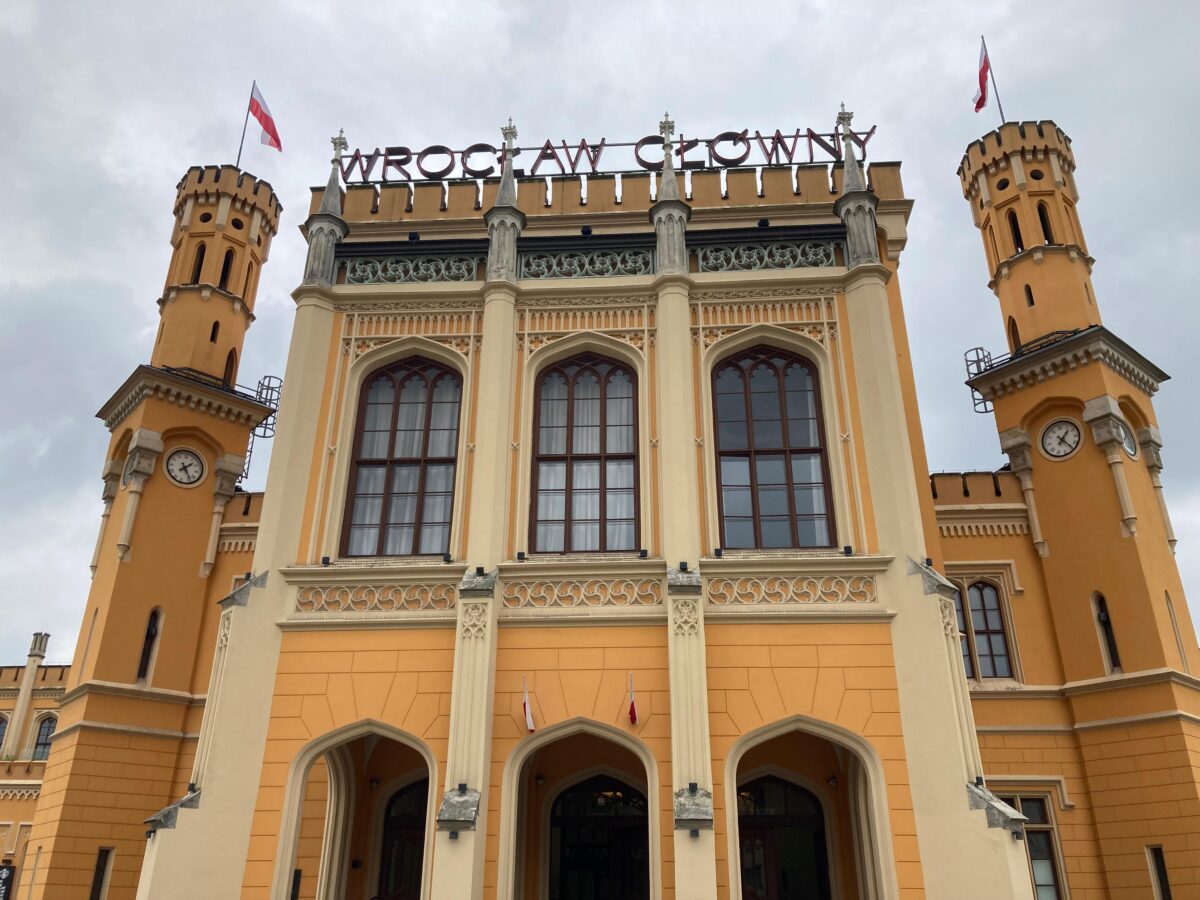
Of course, you can also choose to take trains. Given Wrocław’s location close to the German border, there are trains from Berlin that arrive every day, and this might be your most comfortable way to get to Wrocław from Germany, since flights are usually expensive from Germany. There are also trains from Vienna, Budapest, and Prague! And of course, you can take trains from major Polish cities, although if you are centered in Warsaw, the train can be quite long, over 4 hours, which is not usually worth the price compared to using a bus.
Of course, you can also drive. If you are arriving in Warsaw or Kraków, you could choose to rent a car and drive to Wrocław from where you started. There are many good highways between Wrocław and Warsaw, and between Katowice, Kraków, and Wrocław. Just note that some of these roads, especially between Kraków and Wrocław, are toll roads, and so you either need to set up the ability to pay your tolls online ahead of time or take slower regional highways to avoid the tolls.
All in all, Wrocław is a well-connected city, and you should not have any trouble finding an inexpensive method to get there, whether via direct flight, or an inexpensive train or bus from another destination within Poland.
How to Get Around in Wrocław
Wrocław is mostly flat, so it is easy to get around. Overall, most of the main attractions are in the center, or within a 10–15-minute walk of the center, so you will probably walk most of the time you are in Wrocław. If you have a bike with you, or want to rent one, biking is also a great way to get around, although I would avoid the Market Square when biking, as it gets quite busy there.
For some of the attractions that might be a bit farther away from the center or your accommodation, such as Centennial Hall, Wrocław has a great public transportation system. There are over 20 tram lines that crisscross their way through the city, as well as many more buses that go where the trams cannot. Fair warning that the trams have a bit of a bad reputation, due to issues in the pass with crashes (which is now a bit of a meme amongst Polish youth, or so I am told). However, you should not be concerned anymore, Wrocław has modernized many of their trams, and I never felt unsafe while riding.
If you plan to use public transportation, I recommend downloading the free ap Jakdojade. This app, in Wrocław at least, had more correct transit schedules than Google Maps. Jakdojade is super easy to use and is available in English. You can also choose to pay for tickets through the app. However, it is relatively easy to buy transit tickets in Wrocław. You can buy single-use tickets on all buses and trams, but only with contactless payment. A single ticket costs 4.60/2.30 PLN.
If you want to pay with cash or want to buy a multi-day pass like I did for my three days, you can do so from the ticket machines that are typically at major tram stops, although not at any near the city center that I could find. But, if you are arriving at the train or bus station, there are machines there.
A 24-hour ticket costs 15/7.50 PLN, a 48-hour ticket costs 26/13 PLN, and a 72-hour ticket costs 32/16 PLN. If you are staying longer, the 7-day ticket is a valuable ticket, at only 54/27 PLN. If you plan to ride the public transportation 2 or more separate times per day, which is likely, purchase any of these tickets to save money.
It is of course also possible to drive, although parking is quite sparse in Wrocław, and you would be better off saving the car for your desired day trips, or for those destinations away from the city center. If you want to explore all the attractions close to Centennial Hall, there is a lot of parking that you can pay for over there, and the prices did not seem too bad. Other than that, I would recommend walking or using public transportation as much as possible, it is the best way to see the city.
Safety Tips in Wrocław
Wrocław, like Poland in general, is a very safe city. However, there are still three tips I have for you to be safe and healthy while traveling in Wrocław.
- There are a few scammers in the Old Town that you should watch out for. The main one I saw is the classic “shove a rose in your face and then expect you to pay for it.” However, if you grab it, you DO NOT have to pay. Just give it back to the person and kindly say, “No thanks.” There are also lots of donation peoples in the Market Square especially, and as I have said before in other articles, I would recommend choosing to donate online and not to people directly, just to make sure your donation goes to the right place and not to “administrative” fees.
- If you are looking for a safe place to use the bathroom, malls are always a safe bet! Luckily, the very large Galeria Dominikańska is found just east of the Market Square and is a great place to shop and use the bathroom for free. There are also free toilets spread around the city, including quite a few on the islands of the Oder. In general, you should never have to pay for the bathrooms, and the free ones are safe and clean.
- Watch out for trams! I mentioned that the trams have a bit of a reputation. Part of this is because the tram lines shift between being on the side of the road, in the middle, and on the road, often very suddenly. Additionally, many of these transitions do not have signals to force cars to yield if a tram is coming. Thus, whether you are driving or a pedestrian, ALWAYS look around before crossing tram rails, as the trams can come suddenly!
How Long Should I Spend in Wrocław
Wrocław is a very good-sized city with lots to do, as I hope you saw earlier. I omitted many things from the list as well. Thus, you could spend a leisurely week in Wrocław if you wanted, trying delicious cuisine, wandering up the Oder, and admiring the stunning Market Square. However, I spent around 2.5 days, and I found that sufficient. However, I wished I could have spent more time. So, maybe 3-4 days is enough time to appreciate everything you might want to. Honestly, if you had a week in Poland, and could only choose two cities, Wrocław should be one of them.
However, you could do Wrocław in a day or overnight trip if you wanted to drive from Katowice or Kraków (which is a bit of a long drive). Just focus on the Market Square, Old Town, and a few of the museums that seem most interesting, and you should still be able to gain a great appreciation for the beauty of Wrocław.
Conclusions about Wrocław
Wrocław is a charming city. It offers everything you could want to do, from beautiful architecture, stunning and romantic walks, beautiful parks, engaging museums, and activities for all ages and especially children. In other words, if you can manage, visiting Wrocław should be high on your list of things to do when coming to Poland. I think you will fall in love with the city as much as I did in the short 3 days I spent there.


